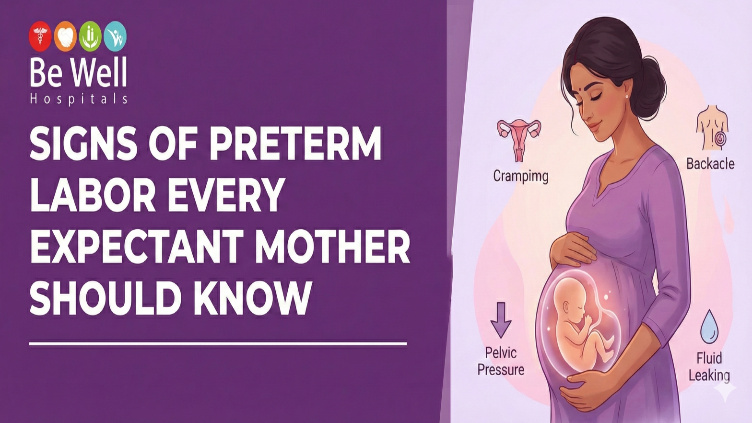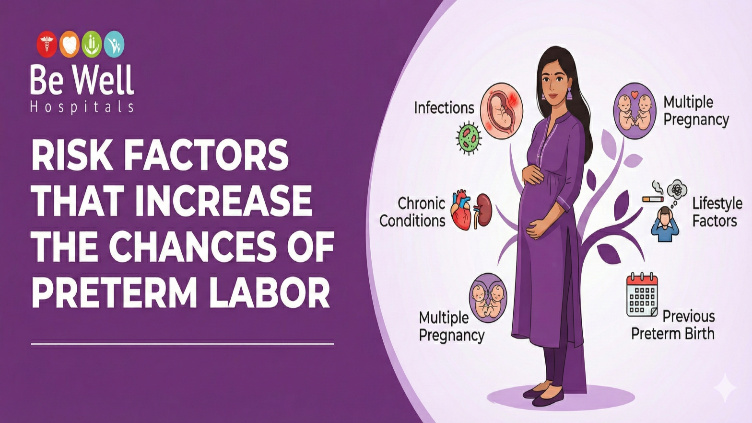
Introduction
Preterm labor occurs when the body begins preparing for delivery too early — before 37 weeks of pregnancy. Many women overlook or misunderstand early symptoms because they often resemble normal pregnancy discomforts. However, timely recognition can significantly improve outcomes. Early detection not only allows doctors to slow or manage preterm labor effectively but also gives the baby more time to develop, reducing the risk of complications. From persistent lower back pain and abdominal cramps to unusual discharge or pressure, understanding these early signals empowers expectant mothers to respond quickly and protect their health and their baby’s well-being.
Why Preterm Labor Needs Attention
Preterm labor happens when uterine contractions begin affecting the cervix earlier than expected, leading to possible premature birth. Babies born before full maturity may face challenges with breathing, feeding, infection control, and long-term developmental outcomes. For mothers, early labor can bring physical and emotional stress, requiring prompt medical intervention. Recognizing the urgency behind these symptoms matters because many cases of preterm labor can be delayed or safely managed when identified early. With awareness and timely care, mothers can significantly increase the chances of healthier outcomes for their babies.
Early Warning Signs You Should Never Ignore
Preterm labor often begins subtly, making it important for pregnant women to observe their bodies closely. The following symptoms are key indicators:
- Regular Contractions: More than four to six contractions in an hour, even if mild, may signal true labor rather than normal Braxton Hicks tightening.
- Persistent Lower Back Pain: A dull, continuous ache that doesn’t ease with rest can indicate uterine activity.
- Pelvic Pressure: A feeling of heaviness or downward force, as though the baby is pushing down, may suggest cervical changes.
- Changes in Vaginal Discharge: Watery, mucus-like, or bloody discharge can signal premature membrane rupture or early dilation.
- Abdominal Cramps: Menstrual-like cramps or discomfort similar to indigestion may indicate early labor.
Being attentive to these symptoms and acting quickly can help prevent premature delivery and related complications.
Subtle Symptoms That Often Go Unnoticed
Some symptoms of preterm labor may blend into everyday pregnancy discomforts, which is why many mothers overlook them. Mild abdominal cramps that come and go, feelings of pelvic heaviness, or flu-like symptoms such as nausea, vomiting, or diarrhea may appear harmless but can trigger dehydration — a common cause of uterine contractions.
Increased urgency to urinate, or pressure that feels different from typical pregnancy-related discomfort, can also indicate early changes in the cervix. These subtle signs shouldn’t be ignored, especially when they persist or occur together. Discussing them with your doctor ensures early evaluation and timely medical support, helping protect both mother and baby.
When to Call Your Doctor or Visit the Hospital
Certain symptoms require immediate medical attention during pregnancy. Contact your doctor or visit the hospital right away if you experience:
- Regular contractions occurring every 10 minutes or less
- Persistent back pain that doesn’t improve with rest
- Abdominal cramps or tightening that continues despite hydration
- Leaking fluid, which may indicate premature rupture of membranes
- Bright red vaginal bleeding
- A sudden or noticeable decrease in the baby’s movements
Even if you feel unsure, it’s always safer to get checked. Early evaluation can help slow or stop preterm labor and allow your baby valuable additional time for development.
Doctors may recommend rest, hydration, medications, monitoring, or treatments to delay delivery. Your proactive response can make a significant difference in ensuring a safe pregnancy journey.
Risk Factors That Increase the Chances of Preterm Labor

Understanding your personal risk is an important step in prevention. While preterm labor can happen to anyone, certain medical, pregnancy-related, and lifestyle factors increase susceptibility.
Medical Factors
- Previous preterm birth or miscarriage
- Short interval between pregnancies (less than six months)
- Urinary or vaginal infections
- Chronic conditions such as hypertension, diabetes, or thyroid disorders
- Structural issues involving the cervix, uterus, or placenta
Pregnancy-Related Factors
- Carrying twins, triplets, or multiples
- Excessive amniotic fluid (polyhydramnios)
- Vaginal bleeding during pregnancy
- Premature rupture of membranes
Lifestyle Factors
- Smoking, alcohol, or drug use
- Being underweight or having poor nutrition
- High stress levels and lack of rest
- Physically demanding work or long hours of standing
Identifying these factors early and addressing them with your healthcare provider can reduce the risk of preterm labor and help you plan a safer pregnancy journey.
Staying Safe: Steps to Lower Your Risk and Stay Calm
While preterm labor cannot always be prevented, adopting mindful habits can significantly reduce risk and improve overall pregnancy health. Staying hydrated helps prevent contractions triggered by dehydration, while adequate rest supports your body’s natural capacity to manage pregnancy changes. Attending all prenatal appointments ensures timely monitoring and early detection of potential issues.
Eating a balanced diet rich in nutrients, taking recommended supplements, and engaging in gentle exercise — such as walking, stretching, or prenatal yoga — can strengthen your body and improve emotional well-being. Managing stress through breathing exercises, meditation, or staying connected with supportive people can also help maintain stability during pregnancy.
Above all, trust your instincts. Any discomfort or change that feels unusual should be communicated to your doctor. Staying informed, calm, and proactive allows you to navigate pregnancy with greater confidence and security for both you and your baby.
Conclusion
Preterm labor can be concerning, but understanding the signs, risks, and preventative measures empowers expectant mothers to act early and protect their babies. When you recognize symptoms promptly and consult your doctor without delay, you give both yourself and your baby the best chance at a safe, healthy outcome. Each week of pregnancy matters, and timely medical care can make a meaningful difference in preventing complications and improving newborn health.
With the right awareness, consistent prenatal care, a healthy lifestyle, and support from medical professionals, many cases of preterm labor can be monitored or managed effectively. Trust your body, pay attention to unusual symptoms, and never hesitate to seek help if something feels off. Your well-being and your baby’s safety always come first.
For expert maternity care, guidance, and support throughout your pregnancy, visit your nearest Be Well Hospitals or call 9698 300 300 to book an appointment with our Obstetrics specialists today.
